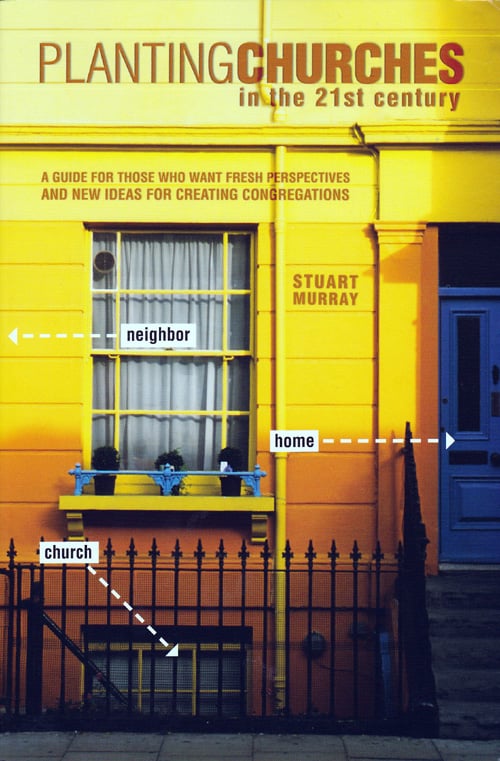What questions do church planters need to ask? Author Stuart Murray, to answer, leaves no stone unturned (almost), and helps us craft a deeply-reflected missionary strategy that is unique to each church planting situation, eschewing a one-size-fits-all approach.
By Kyuboem Lee
- Title: Planting Churches in the 21st Century: A Guide for Those Who Want Fresh Perspectives and New Ideas for Creating Congregations
- Author: Stuart Murray
- North American Edition Publisher: Scottdale, PA: Herald Press, 2010
- Pages: 210 plus additional resources

Stuart Murray has written a book that belongs on the “essential readings” list for those who are involved in the work of church planting in any way–whether you are part of a planting team, thinking of getting involved as part of a supporting cast, part of a planting (or sending) church leadership, or a mission agency whose work involves church planting. He has drawn from his years of urban church planting work in East London, teaching and consulting, and leading Urban Expression, an urban church planting agency, to give us a practical and strategic reference work on the subject. And, though it is rooted in the British soil, it has much to teach the rest of us around the world. That it focuses on the practice of church planting does not mean, however, that Planting Churches is a canned cookie-cutter approach to church planting that presents a how-to guide in an a, b, c format that may work in one narrow context but is inapplicable in all others. Far from it. Murray’s approach, instead, is to identify “strategic questions and [offer] a framework for reflection, prayer, and action.”1
This approach works remarkably well. By raising almost all the critical questions, Murray leads the reader into a process of constructing a church planting strategy that is tailor-made to each work’s unique context, makeup of the planting team, model of church planting process, and so on. Indeed, no two church planting situations are alike, and this calls for highly contextualized approaches. Pat answers are ineffective if not harmful. Many of the problems church planters encounter can be traced to the planters’ uncritical reliance on “what worked” elsewhere, or to their oft-unexamined purpose of “cloning” their planting church or copying a “successful” church model. However, each new church, as it seeks to begin life in a completely unique set of circumstances, presents a great opportunity to express the body of Christ and further the mission of the kingdom in fresh and creative ways. Murray celebrates this, and encourages the church to embrace this.
At the heart of our church planting methodology is our ecclesiology. In our time, there has been much discussion surrounding ecclesiology–a discussion that has been driven in many ways by the emerging church movement (we include the British “fresh expressions” here). As it relates to church planting, the question becomes “What kind of church are we planting?” Murray enters into this discussion by–you guessed it–posing some critical questions, and the result is a refreshing integration of learning from the challenges posed by the new movements and of learning from some of their excesses and mistakes. Denominational expansionism needs to be challenged, and the rise of the new movements helps all of us reexamine our motives and strategies; this can be a healthy thing for the kingdom. Unthinking herd mentality that exists in the new emerging church movement needs to be challenged, too, however, for these can once again cater to the inward concerns of insider Christians who wish to make the church after their own image. Rather, mission is priority.
That is why Murray states,
…I have been particularly impressed by church planters I have met who are prepared to question their convictions, wrestle with contextual issues for the sake of mission, and engage in an ongoing two-way conversation between their context and their convictions. I have been even more impressed by church planters who have planted a church that does not suit their own preferences but which they are convinced is a more appropriate expression of the gospel in their context.2
This commitment to mission saves the church from both ossified but comfortable (because familiar) church forms that have been shaped by dead traditions and trendy fads that seek to throw off such traditions only to be captured by its own shallow peer pressure of the now.
One of the most important questions posed by Murray is: Have you adequately considered the ministry of church planting in poor urban communities?
In my mind, one of the most important questions posed by Murray is this: Have you adequately considered the ministry of church planting in poor urban communities? If you’ve discounted it, have you done so too quickly, because of the sacrifices demanded and the challenges inherent in such works? This question is repeated at various points in the book, and becomes a refrain with which the reader needs to wrestle and from which the reader cannot move on too quickly, as one often does because one is uncomfortable with the implications. Nevertheless, the mission of the kingdom demands that we wrestle honestly with it.
Unchurched people can be found in all socioeconomic groups and all regions, but the greatest concentration of these is in poor urban communities. Inner-city church planters may, therefore, be pioneering on behalf of others as they explore fresh ways of engaging with individuals and families who may be two or three generations away from any kind of church involvement. Denominations and church-planting agencies may be tempted to avoid the challenge of these communities, but an authentic missionary strategy will surely prioritize them.3
The frontier of urban church planting falls within poor urban communities which will most likely demand cross-cultural ministry, especially now, in our global urban age. Many of the new churches planted in these communities will struggle financially for many years and many won’t experience rapid numerical growth and be well on their way to “sustainability” and “self-sufficiency” in a relatively short amount of time. Many of the planters will have to tread the bi-vocational route–as many before them have in these kinds of neighborhoods. It all amounts to a picture that doesn’t bode well within a cost-benefit analysis. Hence the reluctance to embrace the inner city or shantytown frontier in many discussions about church planting.
However, is not this avoidance of church planting in poor urban communities yet another instance of injustice committed against these communities that have already endured so many? A collective turning of the blind eye to the church planting needs of inner city communities or shantytowns, and an undue focus on church planting in more well-to-do neighborhoods (read, in urban contexts: neighborhoods undergoing gentrification) and in populations that share the same culture and socioeconomic makeup as the middle-class, majority-culture church planters (who happen to make up the majority of the recruited among North American church planting efforts) end up producing a systemic bias against these mission fields. This will end up not only further impoverishing inner city neighborhoods but the whole body of Christ. So it is a welcome refrain that Murray brings to our collective church planting consciousness.
Murray raises these as well as many other questions to which each church planting effort needs to give honest and in-depth reflection. He also devotes a chapter to the questions we need to ask in the life after the birth of a church. Those who are asking “What’s next?” after the fanfare and adrenaline rush of the launch will have a welcome agenda for reflection here. Taken together, these are questions needed by any church leadership that desires to be challenged and refreshed in the strategic dimension of the mission of the church. Murray has given us an important work that will further the cause of the kingdom and greatly help invigorate the discussions about and the work of church planting in the as-yet new century.
Notes
1 Page 12.
2 Page 41.
3 Page 37.



2 thoughts on “Review: Planting Churches in the 21st Century”
Thanks Kyu
I like this guy…
This is a great review and it helped me in a small way to travel with the author of the book. I am enthused by the understanding that church planting is not one size fits all but must be contextualized. We at Missionary Purse Ministry International for 26 years are involved in planting churches in poor rural communities, this review has given us encouragement that our labor is truly not in vain. Thank you.